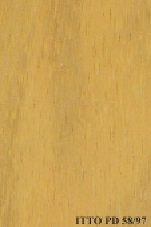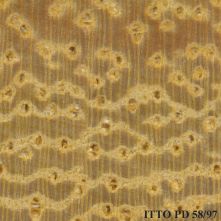
IROKO (Milicia regia)
Trade Name
Iroko
Scientific Name
Milicia regia (A.Chev.) C.C.Berg
Family
MORACEAE
Common Names
Semli (Sierra Leone); Semei (Sierra Leone); Rokko (Nigeria); Semli (Liberia); Semei (Liberia); Pau bicho (Guinea-Bissau); siri (Guinea); Odum (Ghana); Iroko (Côte d`Ivoire); Kambala (Belgium); Molundu (Zaire); Mokongo (Zaire); Lusanga (Zaire); Kambala (Zaire); Mandji (Gabon); Abang (Gabon); Abang (Equatorial Guinea); Kambala (Congo); Abang (Cameroon); Mvuli (Uganda); Mvule (Uganda); Mvuli (Tanzania); Mvule (Tanzania); Mvuli (Kenya); Mvule (Kenya); Mvuli (Ethiopia); Mvule (Ethiopia); Tule (Mozambique); Mufala (Mozambique); Moreira (Angola); Iroko
Scientific Name Synonyms
Maclura regia (A. Chev.) Corner; Chlorophora regia A. Chev.
Description Of The Tree
Botanical Description
The tree reaches a height of 32 to 35 m. Tree is almost unbuttressed. The trunk diameter attains 130 to 200 m.
Natural Habitat
Milicia regia is found in equatorial primary forests, in deciduous and evergreen stands. It is known or inferred that the harvesting of specimens from the wild for international trade has, or may have, a detrimental impact on the species by EITHER exceend
Non Timber Uses
Contains some resins or extracts which could pose problems when machining or finishing.
Wood Identification
Anatomic Description Of Wood
Wood diffuse porous. Occasionally vessels exclusively solitary (over 90%). Tangential diameter of vessel lumina 200 micras or more (large). Tyloses thin walled. Non-vestured pits. Vessels per mm2 less than 6 (rare). Simple perforation plates. Vessel-ray pits lar Axial parenchyma in marginal or in seemingly marginal bands. Axial parenchyma aliform. Axial parenchyma confluent. Prismatic crystals in non-chambered axial parenchyma cells. 3 to 4 cells per parenchyma strand. Rays non-storied. Larger rays more than 4 seriate. Body ray cells procumbent with mostly 2 to 4 rows of upright and/or square marginal cells (Kribs-II). Non-septate fibers. Fibers with simple to minutely bordered pits.
-
 Wood Macro Photo Tangential Plane
Wood Macro Photo Tangential Plane
-
 Wood Micro Photo Of Transversal Section
Wood Micro Photo Of Transversal Section
Availability
Cites Status
Unrestricted
General Wood Description
Color
The sapwood is yellowish white, it has a thickness of 5 to 7.5 cm. The heartwood is yellow brown to dark brown, it is clearly demarcated. The silver figure is fine.
COLOR INDEX (1=Black, 7=Light yellow,white)
5
Grain
Straight or slightly interlocked, sometimes with an influence on further processing operations.
Texture
This species is reported to have a medium to coarse texture.
Luster
The wood surface is described as low in luster.
Natural Durability
Because of variable resistance to decay, this species can be only considered as durable to decay; it can be utilized without preservative treatment for exterior joinery or similar uses. Resistant to termites attack. Heartwood is resistant to Lyctus attack
Natural durability index (1= Very high durability, 7=Vey low durability)
2
Internal Growth Stresses
No residual stresses are reported in this species.
Silica Content
Silica Content: This timber is reported to have a negligible silica content. Silica contents over 0.05% may affect wood processing. Silica Value: 0.01
Resistance To Impregnation
Nearly impossible to treat with a too much low penetration of the preservative substances.
Wood Physical Properties
Basic Density or Specific Gravity (O.D. weight/vol. green) (g/cm³)
0.57
Air-dry Density (Weight and volume at 12%MC) (g/cm³)
0.63
Total shrinkage Tangential (Saturated to 0%MC) (%)
5.0
Total shrinkage Radial (Saturated to 0%MC) (%)
3.1
Drying Defects
Ease of Drying: Air seasoning is reported to be good with little or no degrade.
Recommended Dry Kiln Schedule
FR-6
Dimensional stability ratio (Total Tangential Shrinkage %/Total Radial Shrinkage %)
1.6
Wood Chemical Properties
Wood Mechanical Properties
Bending Strength (MOR),12%MC (kgf/cm²)
806
Stiffness (MOE) 12%MC (kgf/cm²)
107054
Compression parallel to fiber 12%MC (kgf/cm²)
540
Compression perpendicular to fiber 12%MC (kgf/cm²)
69
Shear strength radial 12%MC (kgf/cm²)
84
Janka hardness (side) 12%MC (kgf)
490
Janka hardness (end grain) 12%MC (kgf)
593
Workability
Sawing
It is easy to saw.
Rotary Veneer Cutting
Suitable for slicing, also suitable for peeling if treated.
Sliced Veneer
Suitable for slicing, also suitable for peeling if treated.
Blunting Effect
Slight blunting effect; ordinary tools can be used for sawing and machining.
Machining
Machining of this species is reportedly easy.
Planing
Moderately easy; tools must be cautiously sharpened.
Moulding
Easy; no particular problems.
Turning
30
Boring
Easy; no particular problems.
Mortising
Easy; no particular problems.
Nailing
No particular problem.
Gluing
Difficult to glue because of the extracts content.
Sanding
Easy to perform; it gives good results.
Polishing
Needs pre-coating.
Response To Hand Tools
No particular problems.
REFERENCED USES
End Uses Summary
HOUSING GENERAL, beams, joists, boards, flooring, parquet, frames, steps, panelling, fittings, FURNITURE AND CABINETS, luxury furniture, cabinets, PLYWOOD AND VENEER, faces, Decorative veneer, TURNING, ornaments, turned furniture, cutlery, lasts, CONTAINERS, cooperage, truck bodies, truck flooring, NAVAL CONSTRUCTION, boat deck, port storage, OTHER AND MUSICAL INSTRUMENTS, handicrafts
General Housing
- 10 - Silica in Timbers
Beams
- 11 - Prospect: The wood database
Joists
- 12 - Tropical timbers of the world. Part I-Tropical American Species
Boards
- 13 - Dry kiln schedules for commercial woods. Temperate and tropical. Section III. Latin American (Mexico, Central, and South America) Woods–Conventional Temperatures
Flooring
- 14 - Handbook of Hardwoods
Parquet
- 15 - Empire Timbers
Frames
- 16 - Woods of the World
Steps
- 17 - Tree Conservation Database
Paneling
- 18 - W3TROPICOS Missouri Botanical Garden
Fittings
- 19 - Silica in Timbers
Furniture Cabinets
- 21 - Tropical timbers of the world. Part III-Southeast Asian and Oceanian Species.
Furniture, Luxury
- 22 - Dry kiln schedules for commercial woods. Temperate and tropical. Section IV-Asian and Oceanian Woods
Cabinet
- 24 - Empire Timbers
Panels, Veneers
- 25 - Directory of Timber Trade Malaysia
Faces
- 26 - Annual Review and Assessment of the World Timber Situation 1998-ITTO
Decorative veneer
- 28 - Ministry of Agriculture, Fisheries & Forest of Fiji
Turning
- 30 - Embassy of Honduras in Japan
Ornaments
- 31 - Embassy of Colombia in Japan
Turned Articles
- 32 - Embassy of Cote d`Ivoire in Japan
Knife Handles
- 33 - Embassy of Gabon in Japan
Lasts
- 34 - Embassy of Indonesia in Japan
Cooperage
- 51 - Recopilacion de propiedades mecanicas de maderas creciendo en Chile
Truck Body
- 53 - Timbers of the New World
Truck Flooring
- 54 - Bulletin of the Government Forest Experiment Station N.157: Identification of Tropical Woods
Shipbuilding
- 55 - Tropical Timber Atlas of Latin America
Boat Decking
- 59 - Programa Nacional de uso Sostenible de los Bosques e Incremento a las Exportaciones.
Port Storage
- 62 - Estudio Tecnológico de Maderas del Perú (Zona Pucallpa) Vol I
Handcraft
- 66 - Maderas latinoamericanas. VII. Caracteristicas anatomicas. propiedades fisicomecanicas, de secado, y tratabilidad de la madera juvenil de Cordia alliodora (Ruiz & Pav. Oken.)
Please Provide Information To View Producer Information